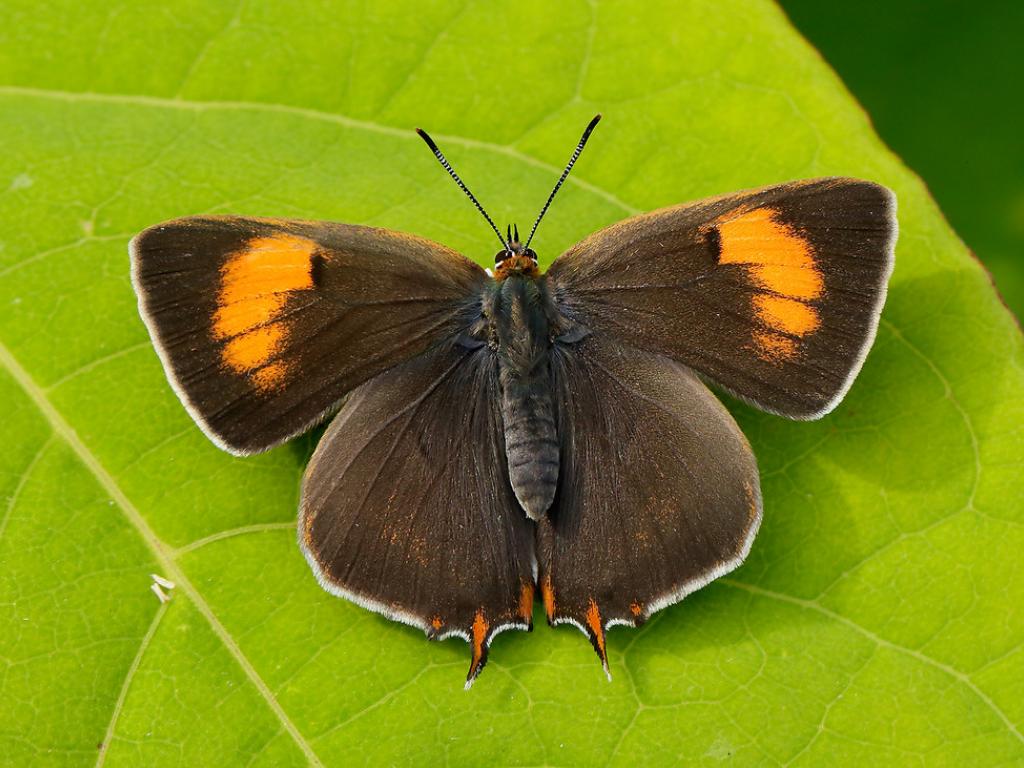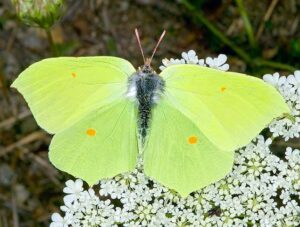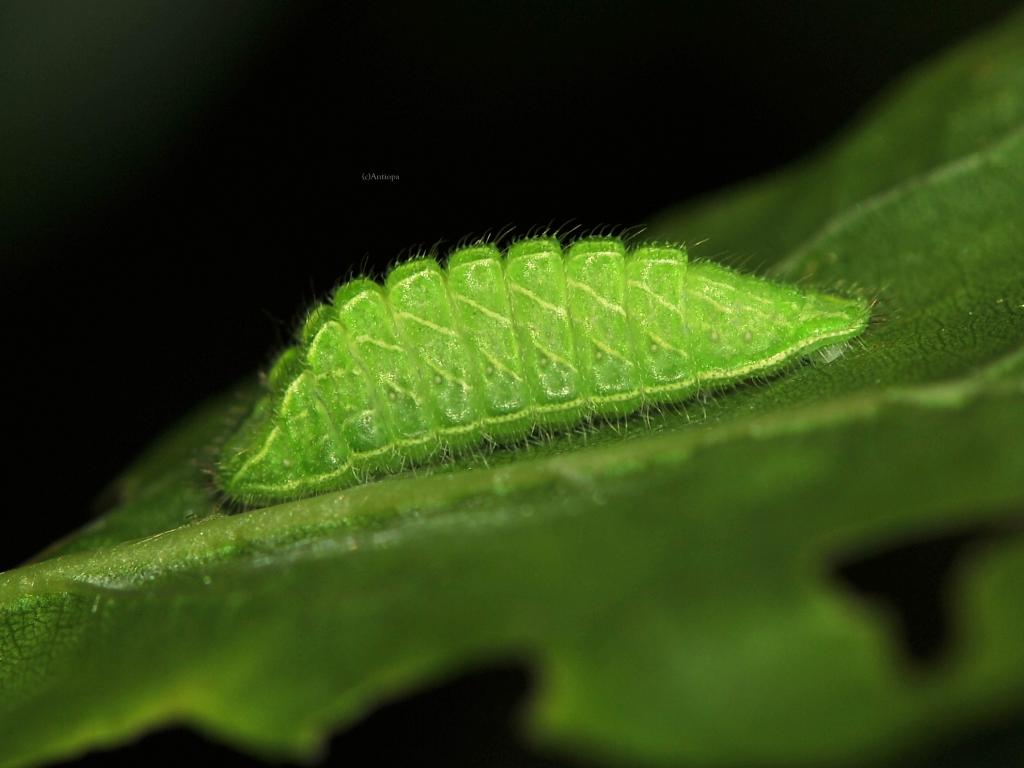
It is worth looking up at prominent Ash trees along wood edges to see if small clusters of adults may be flitting around. They congregate to mate and feed on aphid honeydew. Adults also sometimes feed lower down on flowers such as Hemp-agrimony, Common Fleabane and Bramble. The females are most frequently seen as they disperse widely along hedgerows where they lay conspicuous white eggs on young Blackthorn shoots.
The butterfly often rests with its wings closed showing orange-brown underwings with two wavy white streaks and small tails. Uppersides are brown with an orange mark.
It is locally distributed in southern Britain and mid-west Ireland and has undergone a substantial decline due to hedgerow removal and annual flailing, which removes eggs.
Size and Family
- Family: Hairstreaks
- Size: Small/Medium
- Wing Span Range (male to female): 38-40mm
Conservation status
- Section 41 species of principal importance under the NERC Act in England
- Section 7 species of principle importance under the Environment (Wales) Act 2016
- UK BAP status: Priority Species
- Butterfly Conservation priority: High
- European Status: Not threatened
- Protected under Schedule 5 of the 1981 Wildlife and Countryside Act (for sale only)
Caterpillar Foodplants
The Butterfly breeds on the young growth of Blackthorn (Prunus spinosa) and occasionally other Prunus species such as Bullace (P. domestica).
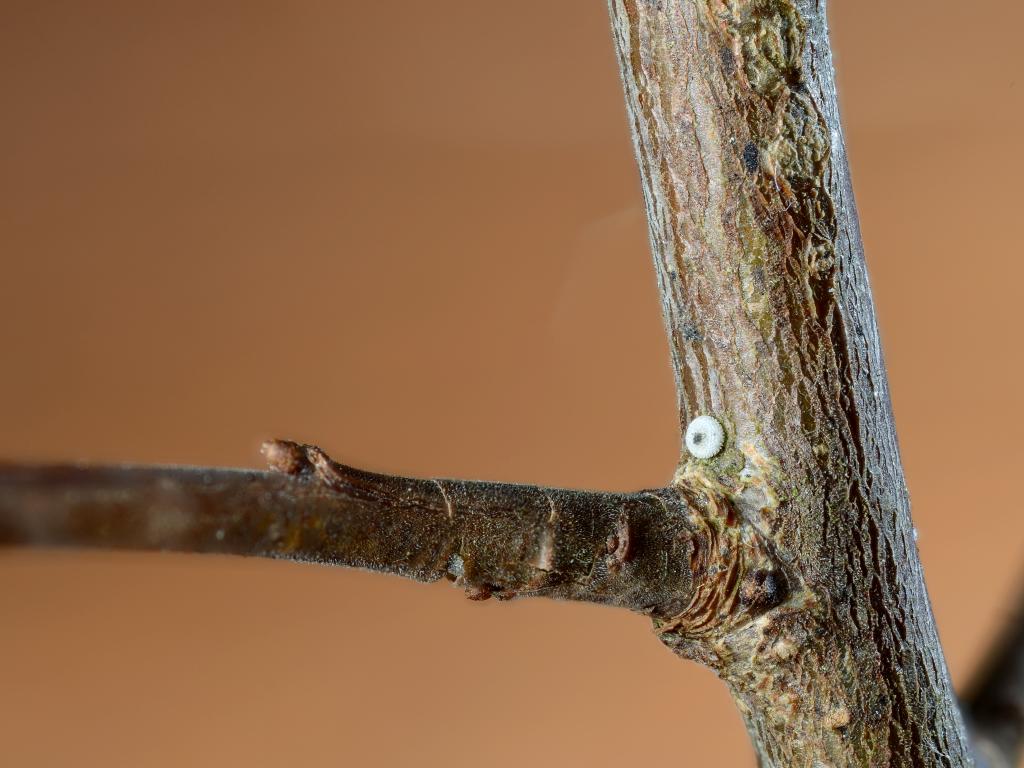
Habitat
Hedges, scrub and woodland edge where Blackthorn is prominent and not flailed every year.
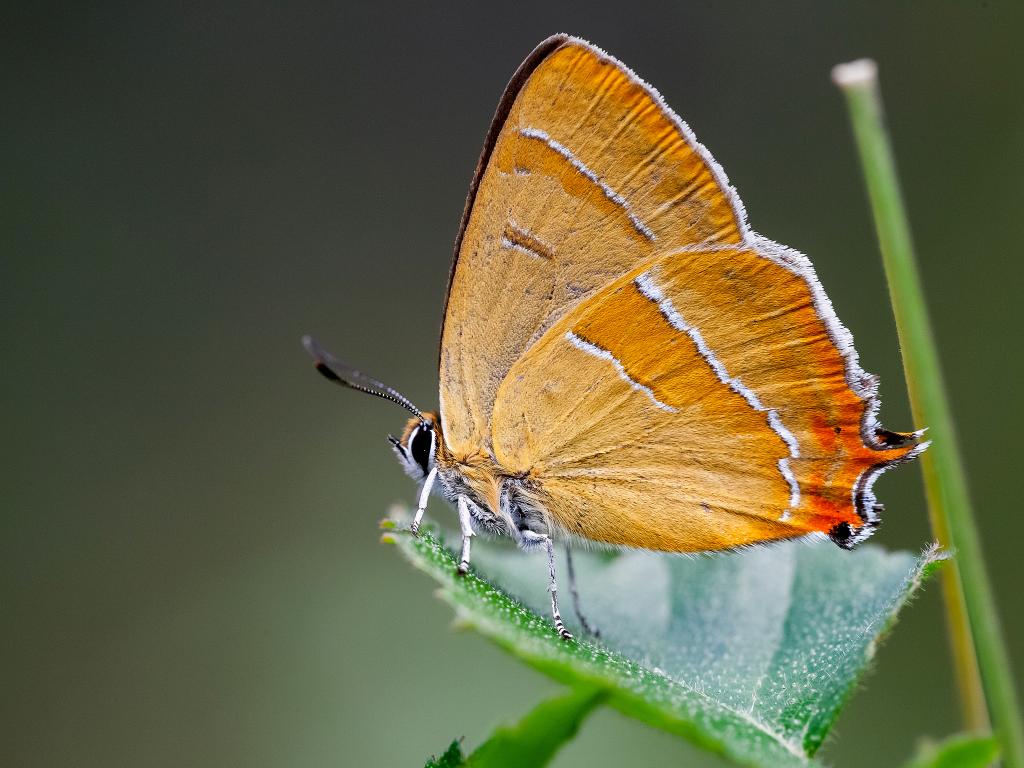
Life cycle and food plants
In Europe the female lays her eggs on blackthorn (Prunus spinosa) in late August which overwinter, hatching the following spring when the buds are breaking. It has been found that the best way to find breeding sites for this species is to look for the conspicuous white eggs in the winter. The larvae are extremely well camouflaged and feed only at night, remaining motionless during the day. Pupation takes place in leaf litter on the ground in late June or early July and are attractive to ants who will bury them in shallow cells.
Distribution
- Countries: England, Wales, and Ireland
- Restricted in the UK to three main centres: south-west Wales, Devon/Somerset and Surrey/Sussex. Other smaller populations occur around Oxford and on Salisbury Plain.
- Distribution Trend Since 1970’s = -49%.
The Brown Hairstreak is one of Britain’s rarest and most elusive butterflies.
The wings are dark brown above, with a distinctive orange mark on the forewing, while the undersides are a rich dark orange small. It lives along hedgerows and small woods, usually on heavy clay soils where there is abundant Blackthorn, the caterpillar food-plant.
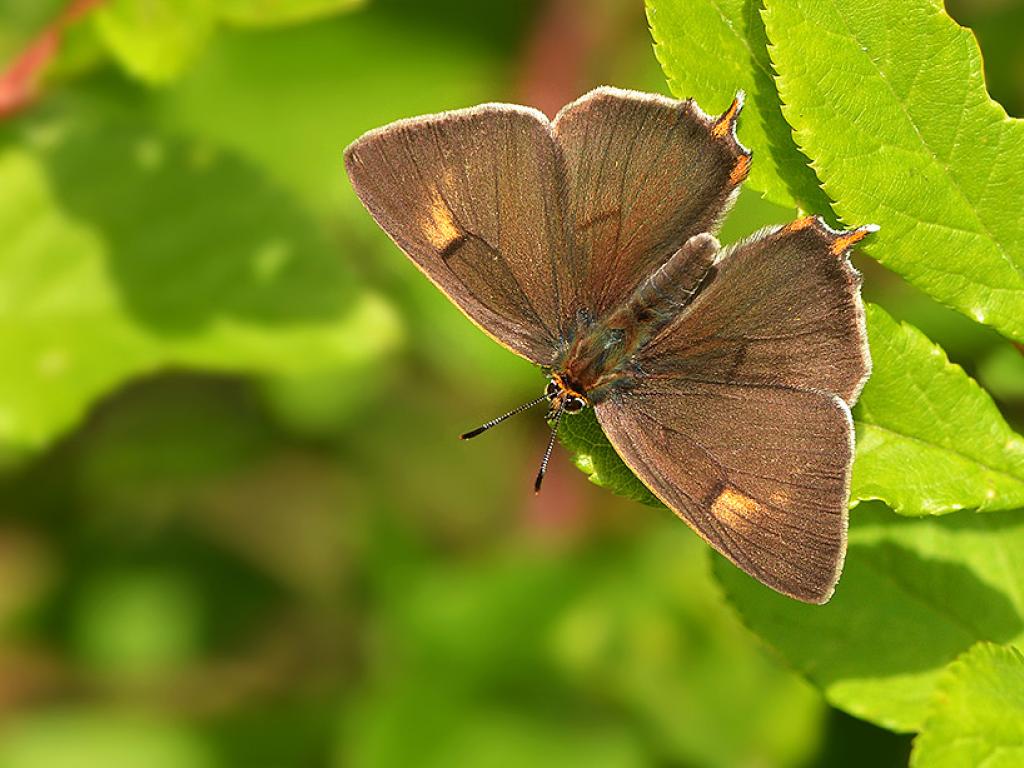
Decline
The Brown Hairstreak is found in several regions of southern and western England and Wales, typically where there is still a dense patchwork of hedges and small woods. The butterfly has declined rapidly over recent decades and its range has contracted by over 60%. It is now listed as a top conservation priority.
The reason for the butterfly’s decline is the loss of hedges, over 50% of which have been removed in the last 60 years in England, and annual flailing. The eggs are laid on the young growth of Blackthorn and are very susceptible to annual cutting by tractor mounted flails. This is now the normal way that hedges are managed but is disastrous for this butterfly and many other hedgerow insects. Before such mechanised cutting, hedges were managed by hand by periodic cutting and laying. This suited the butterfly well as new growth was left for several years before re-laying.
Conservation
The conservation of the butterfly is quite simple. All hedges should be retained and cut on a rotation so that each stretch of hedge is cut every other year, or preferably every 3-4 years. This leaves a good proportion of the hedges uncut so that the eggs and caterpillars can complete the life-cycle. This management is also good for a wide variety of other insects as well as for birds that rely on berries during the winter.
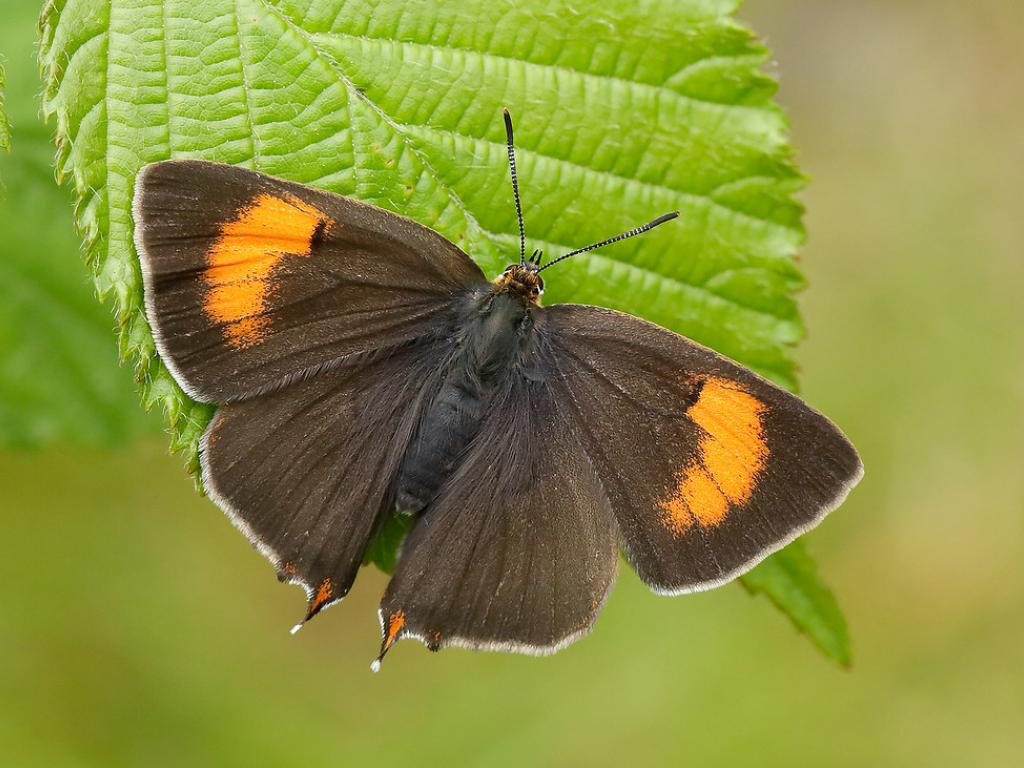
New habitat can also be created by planting hedges using a good proportion of Blackthorn. In areas where the butterfly still survives, new hedges are colonised very quickly, helping populations to thrive. Where possible, it is even better to let the hedgerow produce small suckers into the field margin, as such low growth is often favoured for egg-laying.
Female butterflies disperse widely across the landscape, laying eggs in hedges as they go. Colonies can thus cover several square kilometres of farmland. Farmers thus play a crucial role in the conservation of this beautiful butterfly and can contribute by managing their hedges sensitively.
Elusive adults
The adult butterflies are extremely difficult to spot, so finding one requires a lot of luck or patience, often both. They fly from mid-July to mid-September, but spend most of their time in tree-tops where they feed on honeydew, a sweet liquid that is secreted by aphids when they feed on leaves. The butterflies rarely come down to feed on flowers, but they do occasionally in hot weather or after rain has washed the honeydew off the leaves above.
Tips for spotting the butterfly
Adults often congregate around ash trees, often smaller trees with an open canopy where they can find mates. The best way to spot the butterfly is to go to a good locality and look up into ash trees with binoculars. You might see the spiralling flight as the adults chase each other. The other way is to walk slowly along a hedgerow or wood edge where there is lots of Blackthorn, and search the foliage and flowers for a basking adult. The females come quite low down when egg-laying, often between 1-3 m above ground, and are the most often seen of the two sexes.
Tips for spotting eggs
The Brown Hairstreak is one of the few butterflies that is easier to find in the egg stage than as an adult. Although the eggs are tiny (around 1mm across), they are brilliant white surprisingly easy to find if you know where to look. Eggs are laid on clean new growth of Blackthorn twigs, mostly between 30cm and 2m above ground (so within eye-height!). They can be found throughout the winter and are best looked for when leaves have fallen. They are laid on clean new growth, usually where last year’s growth meets slightly older wood, around 10-20 cm from the tip. They are typically laid in the fork of a side shoot or thorn.
Most surveys of Brown Hairstreak are done by searching for eggs. Local Branches of Butterfly Conservation organise a series of egg searches through the winter to check on colonies and give feedback to farmers.
About
The largest of the UK’s hairstreaks, the brown hairstreak is an elusive butterfly that spends most of its time either high in the tops of large ash trees (called ‘master trees’), or among thick hedges. It is found at woodland edges and along hedgerows in southern England from late July until November. Adults feed on honeydew from aphids, while caterpillars feed exclusively on blackthorn.
How to identify
The brown hairstreak is a large hairstreak, with brown upperwings and small ‘tails’ protruding from the hindwings. Females have a brilliant orange patch in the top corner of each forewing. The underwings are a distinctive bright orange, with two white lines streaked across them.
Did you know?
Female brown hairstreaks lay conspicuous, round, white eggs on young blackthorn shoots. Looking like blackthorn leaves, the older caterpillars are extremely well camouflaged and feed only at night.
This is the largest hairstreak found in the British Isles. It is a local species that lives in self-contained colonies that breed in the same area year after year. This species can also prove elusive, since it spends much of its time resting and basking high up in tall shrubs and trees. The female is particularly beautiful, with forewings that contain large orange patches, and was once considered to be a separate species known as the “Golden Hairstreak”. This species is found in the southern half of England and Wales, and also around the Burren in Ireland. In England its strongholds are in West Sussex, Surrey, Oxfordshire, Buckinghamshire, North Devon and South Devon. Strongholds in Wales are in Cardiganshire and Carmarthenshire. In Ireland it is primarily found in the Burren limestones of Clare and South-east Galway. The northernmost sites are found in North Lincolnshire.

